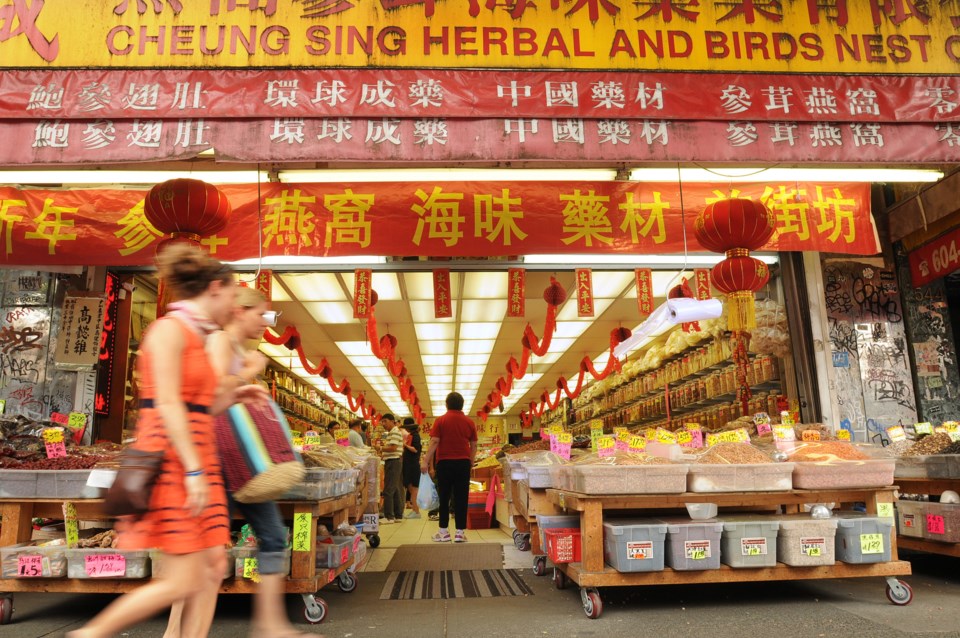Don’t be too quick to write off Chinatown. I say that particularly in light of council’s decision last week to turn down the Beedie rezoning application to build a 118-foot-high condo complex at the confluence of Keefer and Columbia.
There are those among us who have decided, in the words of Gertrude Stein as she lamented the loss of what she knew as the town of Oakland, Calif., in which she grew up, that when it comes to Chinatown, “there is no ‘there’ there.”
It continues to dwindle. Saving what remains is pointless. Expanding what is there is impossible.
But take a walk, as I did this week, south on Columbia from the heavily travelled scene of frequent dysfunction and despair on Hastings Street towards Pender. Within half a block the traffic noise fades, the alley is no longer one populated with drug-dependent souls. You are more likely to encounter a tourist armed with a camera.
At Pender, Chinatown truly begins. Wander into the Chinese Tea Shop. Be dazzled by the near museum quality of the pottery and the stunning array of teas available for tasting if you choose to sit a while.
Yes, Chinatown is changing. No one could have imagined, even a few decades ago, that the multi-storey Chinese clan buildings lining the street would have tenants in their main floor retail spaces, which include Flatspot Longboard Shop or El Kartel, a streetwear store where the owners told me they started out on Robson but rising rents pushed them next to Granville and finally to their current location on Pender.
Before you head another block south towards Keefer, stop by the Chinese bakery and pick up a fresh-out-of-the-oven Gai Mai Bao bun. Never mind the calorie count.
It is at Keefer where you will come across the vacant lot where the contentious proposal was planned for.
Immediately in front of that site is a monument to Chinese railway workers and Second World War Chinese Canadian vets, commemorating the sacrifices they made “in building a united and prosperous Canada.”
Across the street to the west is the Chinese Cultural Centre. Next to that is the Dr. Sun Yat-Sen Park. Both structures, as longtime Chinatown activist Shirley Chan reminded me, are the beneficiary of an earlier battle to save Chinatown. Back in the day when the fight was on to stop the cross-town freeway, that land had been set aside by the city as a highway intersection.
Years later, in 2010, when the city decided that to save Chinatown they would have to increase the heights and density of any new buildings, Chan recalls that the site of the Beedie proposal was given special consideration for being excluded except in “special circumstances.”
That somehow got overlooked. And what resulted from the increase in heights and density on other properties led not to more folks coming back to Chinatown, but to an increase in property values and taxes. “It was a mistake,” says Chan.
As the movement to stop the Beedie project grew to include everyone from millennials of Chinese heritage to Chinese Canadian war vets to low-income seniors, splits became apparent among clan members. There were those who wanted the project; it included some low-cost seniors housing.
The belief also grew among Chan, and the rest of those opposed to the project, that the city would approve it. After all, it had been revised and then revised again to satisfy the city’s urban design panel. Finally, city staff recommended it and the proposal was sent to public hearing where literally hundreds of interveners spoke.
Then, on the day of the council decision, the first on his feet to vote was Coun. Kerry Jang. He was opposed to the project. Chan was surprised. And it was just the beginning of what ended as an 8-3 vote to kill the project.
Chan was elated, as were her seat mates: Chinese-Canadian veterans.
In the lobby outside council chambers I found urban planner Andy Yan wiping tears of joy from his eyes. “We started,” he said “as the Charge of the Light Brigade,” a disastrous exercise by British cavalry soldiers during the Crimean war.
“We ended with the Battle Hymn of the Republic.” Glory! Glory! Hallelujah.
But, as Chan says, there is still “more work to be done” to ensure Chinatown’s future.
@allengarr



